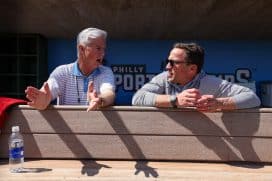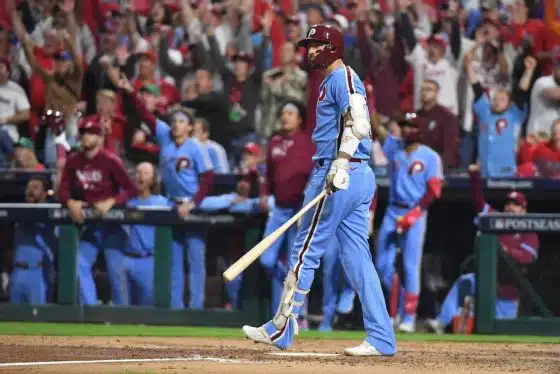Flyers
Flyers: Frost Lineup Saga Clouds Rebuild Commitment

At the start of the season, the Flyers opted to keep both Tyson Foerster and Bobby Brink on the roster and rotate them into the lineup, an extension of sorts on training camp. That lasted two games, when the Flyers lost 5-2 to Ottawa in the second game of the season and decided to make a lineup change.
Morgan Frost came out of the lineup ahead of the home opener. He remained out for another five games beyond that.
When the Flyers suffered another similar loss to Anaheim two weeks later, it presented the perfect opportunity to get Frost back in the lineup. He played in the last four games, the latter two of which the team was without Sean Couturier due to injury.
On Tuesday night, Couturier returned to the lineup, and Frost was back in the press box as the extra forward. It brought the lineup saga back to the surface.
Land of Opportunity?
The issue isn’t Frost in and of itself. In fact, you’d be better off removing Frost’s name from the scenario and letting the other facts take over.
In the first four games of the season, the Flyers had rotated in two 22-year-old forwards. They swapped a 23-year-old and 21-year-old defenseman. When they made a decision to play both forwards, a 24-year-old center came out of the lineup. When he finally returned, another 24-year-old forward came out of the lineup. In the team’s loss to the Kings on Saturday, another 23-year-old defenseman was benched for the third period.
For a team that has stated they are in a full-on rebuild, this is an unusual way to show it. For all the preaching of “playing the kids” and a “land of opportunity,” it’s been anything but.
Frost has hardly played well enough to be immune to lineup decisions. But you compare the other players in his age group, the likes of Noah Cates, Owen Tippett, Joel Farabee, and especially Foerster and Brink, and there’s not one singular player who has stood out enough to make the decision so crystal clear. There are various options, but the odd man out has been consistent.
Two Sides of Future Building
If you are in a rebuild, the intention should be on the opportunity. The goal is to find out what you have and what can be a true part of the future, especially while your season-long goals are not rooted in total points, wins, or playoff status. Frost is as much a part of that as anybody in the 25-and-under group.
But Frost isn’t so much as given the chance, because at the first opportunity to make a change to the lineup, he’s back out of the lineup. To this point, Frost has played in just six of the team’s 13 games.
The greater issue is that, again, it’s not specifically about whether Frost truly becomes part of the long-term future, but the denial of the opportunity when others have not out-performed him. Yes, Frost has no points this season. But go look at some of his teammates. Cates has four points. Foerster has two points, and is still searching for his first goal of the season. Tippett has six points, but only two goals in the first month of his follow-up season to 27 goals.
Even if the relationship with Frost were already beyond saving, or the opportunity is simply non-existent to both coach and front office, keeping him out of the lineup equally doesn’t help the team move on. If you have interest in trading Frost, he needs to play to keep his value reasonable. Instead, keeping him in the press box simply plummets it.
Setting an Uneven Standard
John Tortorella has been all about setting a standard and building a culture. He’s been all about playing the game the right way. He’s stressed that despite everything, the team’s trying to win.
But how can that be the case when Frost presents a better opportunity to win, based on both eye test and analytics, than some of his teammates at the moment? How are you truly setting a standard when the goalposts appear to be moved for different players?
The greater issue in the Frost lineup saga isn’t Frost himself. It’s the idea that today, it’s Morgan Frost who is in the doghouse with no end in sight. Tomorrow, it may be somebody else who could have a future with the team that is put out to pasture.
It creates a clouded approach to the rebuild, and one that provides more questions than answers about the team’s way of trying to build a contender.












































